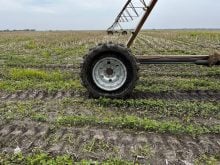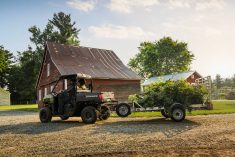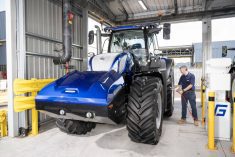Most farms have already put away the compact equipment used for summer yard care — but will it start right up and get right to work in the spring?
It may, if it was stored correctly for the winter, Kioti product line manager Joel Hicks says.
“Some green industry professionals assume they can simply park their compact tractors until spring, or a quick tuneup is all it takes to get ready for winter work. In reality, proper winter maintenance involves much more.”
Read Also

Claas brings 1000 Series SP forage harvesters to Canada
In mid-August, Claas unveiled its new line of Jaguar forage harvesters at an event in Visalia, California, deep in the heart of that state’s dairy region.
Why it matters: Time spent on out-of-season equipment maintenance and proper storage translates to less time spent on repair when farmers have no time to spare in season.
And he adds he’s heard a lot of misconceptions from owners over the years.
First, many owners think fall maintenance isn’t required unless the machine will be exposed to harsh winter elements. That’s not always the case. Long storage periods can cause problems in compact equipment, just like any other machine.
Here are his basic maintenance recommendations:
First, ensure tire pressures are correct and periodically checked throughout the winter.
“Tire pressure drops when temperatures drop,” Hicks says. “Keeping inflation pressures up will help extend tire life.”
“Using a quality cover and parking the machine on blocks is another great option.”
Rodents can become a problem during storage. Keeping machines inside a shop or garage won’t likely stop them. In fact, it may make it more likely as mice look for sheltered winter homes. So, take measures to keep them out or caught before they start doing damage.
Fluids, especially gasoline, can break down over long storage periods and condensation can collect inside tanks. Adding fuel stabilizer and ensuring the engine runs long enough to pull some into the carburetor can save a lot of fuel system headaches in the spring.
Changing oil before storage can ensure contaminants from combustion during seasonal use aren’t left to cause any deterioration inside the engine.
Exposed metal surfaces can be subject to corrosion. Touching up areas with paint chips and coating exposed surfaces with a rust preventative can help prevent that.
But of course, you can’t paint over dirt, and debris buildup, which also helps promote corrosion. “A thorough cleaning can reduce the risk of long-term damage to your equipment,” Hicks says. “A little dirt and debris can lead to worse things, like small animals creating nests in your equipment. Taking the time for cleaning can save some time in the spring.”
You should also disconnect batteries during storage. Small power draws can pull voltage down over time and increase the risk of a battery freezing or discharging too fully. It also provides an opportunity to clean cables and check over wiring.
With so much equipment on a farm needing maintenance, it’s easy to overlook the small seasonal-use machines. So be sure to add them to the farm’s maintenance schedule log.
Even small machines can get expensive, Hicks notes, so spending some time giving them a little love in the fall is definitely worth the effort.
“It also protects your investment and helps ensure long-term reliability,” he says.





















